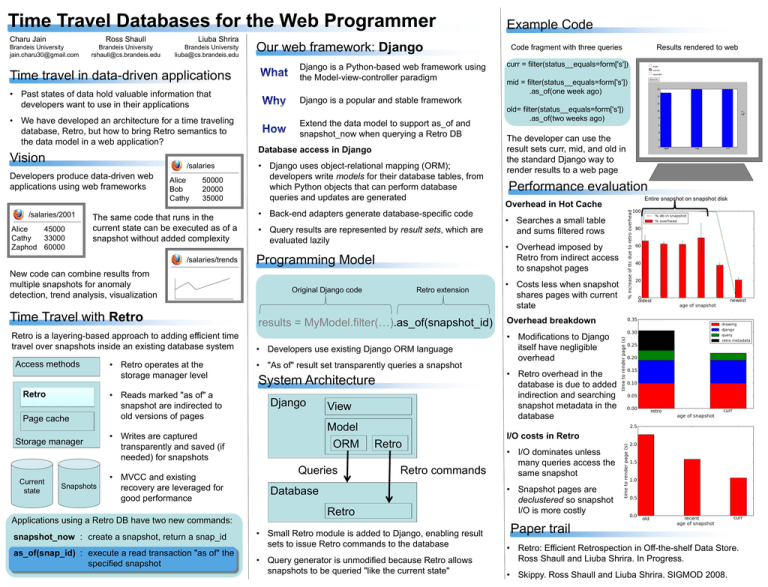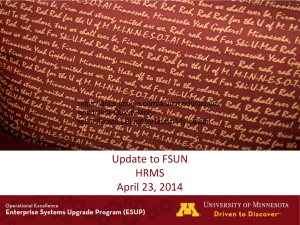pptx - Brandeis University
advertisement

Time Travel Databases for the Web Programmer Charu Jain Ross Shaull Brandeis University jain.charu30@gmail.com Brandeis University rshaull@cs.brandeis.edu Liuba Shrira Brandeis University liuba@cs.brandeis.edu Our web framework: Django Time travel in data-driven applications Django is a Python-based web framework using the Model-view-controller paradigm • Past states of data hold valuable information that developers want to use in their applications Django is a popular and stable framework • We have developed an architecture for a time traveling database, Retro, but how to bring Retro semantics to the data model in a web application? Extend the data model to support as_of and snapshot_now when querying a Retro DB Vision /salaries Developers produce data-driven web applications using web frameworks /salaries/2001 Alice 45000 Cathy 33000 Zaphod 60000 Alice Bob Cathy 50000 20000 35000 The same code that runs in the current state can be executed as of a snapshot without added complexity /salaries/trends New code can combine results from multiple snapshots for anomaly detection, trend analysis, visualization Time Travel with Retro Retro is a layering-based approach to adding efficient time travel over snapshots inside an existing database system Access methods Retro Page cache Storage manager Current state Snapshots • Retro operates at the storage manager level • Reads marked "as of" a snapshot are indirected to old versions of pages Database access in Django • Django uses object-relational mapping (ORM); developers write models for their database tables, from which Python objects that can perform database queries and updates are generated • Back-end adapters generate database-specific code • Query results are represented by result sets, which are evaluated lazily Programming Model Original Django code Applications using a Retro DB have two new commands: snapshot_now : create a snapshot, return a snap_id as_of(snap_id) : execute a read transaction "as of" the specified snapshot Code fragment with three queries mid = filter(status__equals=form['s']) .as_of(one week ago) old= filter(status__equals=form['s']) .as_of(two weeks ago) The developer can use the result sets curr, mid, and old in the standard Django way to render results to a web page Performance evaluation Overhead in Hot Cache • Overhead imposed by Retro from indirect access to snapshot pages • Costs less when snapshot shares pages with current state • Developers use existing Django ORM language • Modifications to Django itself have negligible overhead System Architecture Django View Model ORM Queries Retro Retro commands Database Retro • Small Retro module is added to Django, enabling result sets to issue Retro commands to the database • Query generator is unmodified because Retro allows snapshots to be queried "like the current state" Entire snapshot on snapshot disk • Searches a small table and sums filtered rows Overhead breakdown • "As of" result set transparently queries a snapshot Results rendered to web curr = filter(status__equals=form['s']) results = MyModel.filter(…).as_of(snapshot_id) • Writes are captured transparently and saved (if needed) for snapshots • MVCC and existing recovery are leveraged for good performance Retro extension Example Code • Retro overhead in the database is due to added indirection and searching snapshot metadata in the database I/O costs in Retro • I/O dominates unless many queries access the same snapshot • Snapshot pages are declustered so snapshot I/O is more costly Paper trail • Retro: Efficient Retrospection in Off-the-shelf Data Store. Ross Shaull and Liuba Shrira. In Progress. • Skippy. Ross Shaull and Liuba Shrira. SIGMOD 2008.







